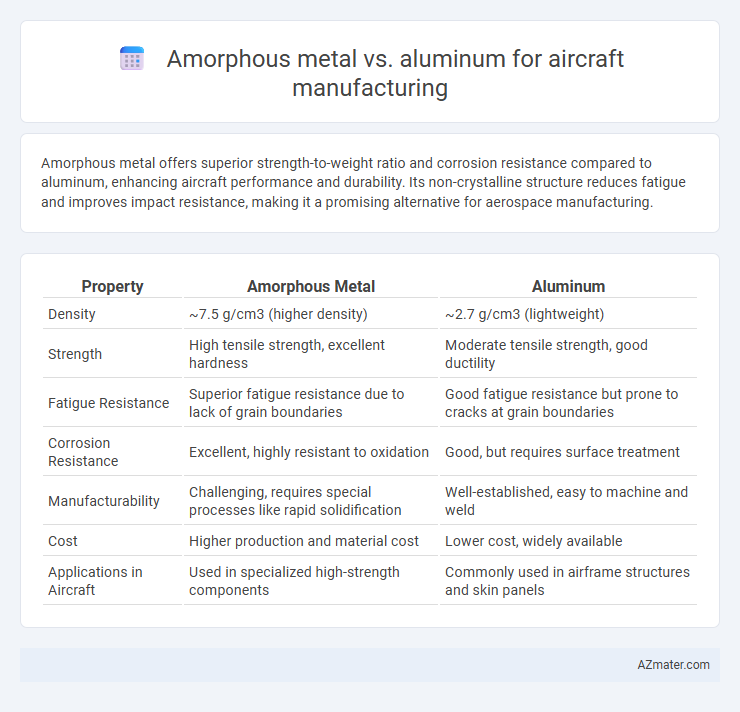Amorphous metal offers superior strength-to-weight ratio and corrosion resistance compared to aluminum, enhancing aircraft performance and durability. Its non-crystalline structure reduces fatigue and improves impact resistance, making it a promising alternative for aerospace manufacturing.
Table of Comparison
| Property | Amorphous Metal | Aluminum |
|---|---|---|
| Density | ~7.5 g/cm3 (higher density) | ~2.7 g/cm3 (lightweight) |
| Strength | High tensile strength, excellent hardness | Moderate tensile strength, good ductility |
| Fatigue Resistance | Superior fatigue resistance due to lack of grain boundaries | Good fatigue resistance but prone to cracks at grain boundaries |
| Corrosion Resistance | Excellent, highly resistant to oxidation | Good, but requires surface treatment |
| Manufacturability | Challenging, requires special processes like rapid solidification | Well-established, easy to machine and weld |
| Cost | Higher production and material cost | Lower cost, widely available |
| Applications in Aircraft | Used in specialized high-strength components | Commonly used in airframe structures and skin panels |
Introduction to Amorphous Metals and Aluminum in Aviation
Amorphous metals, also known as metallic glasses, offer exceptional strength, corrosion resistance, and lightweight properties, making them promising materials for aircraft manufacturing. Aluminum, a traditional choice in aviation, provides excellent machinability, corrosion resistance, and a favorable strength-to-weight ratio essential for structural components. The comparison highlights amorphous metals' potential for enhanced mechanical performance and durability against aluminum's established reliability and cost-effectiveness in aerospace applications.
Material Structure: Amorphous Metals vs Aluminum
Amorphous metals feature a non-crystalline, disordered atomic structure that provides superior strength and corrosion resistance compared to the crystalline lattice structure of aluminum alloys commonly used in aircraft manufacturing. This lack of grain boundaries in amorphous metals results in higher hardness and enhanced fatigue performance, making them particularly advantageous for structural components subjected to cyclic stresses. Aluminum, while lightweight and easy to process, is more prone to grain growth and stress corrosion cracking, limiting its durability under extreme operational conditions.
Mechanical Strength and Durability Comparison
Amorphous metals exhibit superior mechanical strength compared to aluminum alloys commonly used in aircraft manufacturing, often exceeding tensile strengths of 2,000 MPa versus aluminum's typical 400-600 MPa range. The atomic structure of amorphous metals, lacking grain boundaries, enhances durability by improving resistance to fatigue, wear, and corrosion under cyclic loading conditions. While aluminum offers lightweight and cost advantages, the exceptional strength-to-weight ratio and higher endurance limits of amorphous metals make them promising candidates for critical aerospace components requiring long-term reliability.
Weight and Density Advantages for Aircraft Design
Amorphous metals offer a significant advantage in aircraft manufacturing due to their lower density, typically around 7.2 g/cm3, compared to aluminum's average density of 2.7 g/cm3, enabling optimized weight distribution and structural efficiency. Despite being denser, specific amorphous metal alloys provide enhanced strength-to-weight ratios, allowing designers to reduce overall aircraft weight without compromising durability. This weight reduction translates to improved fuel efficiency and increased payload capacity in aerospace applications.
Corrosion Resistance in Aerospace Environments
Amorphous metals offer superior corrosion resistance compared to aluminum in aerospace environments due to their non-crystalline atomic structure, which eliminates grain boundaries prone to corrosion initiation. This enhanced resistance reduces maintenance costs and extends aircraft component lifespan under harsh conditions such as saltwater exposure and fluctuating humidity. Aluminum, while lightweight and widely used, remains more susceptible to pitting and galvanic corrosion, requiring protective coatings to maintain structural integrity.
Manufacturing Processes and Scalability
Amorphous metals, with their non-crystalline atomic structure, require specialized manufacturing processes like rapid solidification or melt-spinning, which limit scalability compared to aluminum's well-established casting and extrusion methods. Aluminum benefits from mature, cost-effective large-scale production techniques, enabling widespread adaptability in aircraft manufacturing. Despite their high strength-to-weight ratio, the complexity and expense of amorphous metal production hinder their scalability relative to aluminum alloys.
Cost Analysis: Production and Lifecycle
Amorphous metals in aircraft manufacturing offer higher material strength but come with increased production costs due to complex processing and limited large-scale manufacturing capabilities compared to aluminum. Aluminum benefits from established, cost-efficient production methods and a well-understood recycling infrastructure, reducing lifecycle expenses significantly. Lifecycle cost analysis shows aluminum's weight and corrosion advantages contribute to overall maintenance savings, whereas amorphous metals offer potential fuel efficiency gains that may offset initial higher costs in long-term use.
Impact on Fuel Efficiency and Performance
Amorphous metals exhibit higher strength-to-weight ratios and superior fatigue resistance compared to aluminum, contributing to lighter aircraft structures and enhanced fuel efficiency. Their unique atomic structure enables better energy absorption during impacts, improving overall aircraft performance and safety. Aluminum remains widely used due to its lower cost and manufacturability, but amorphous metals offer promising advancements for fuel-efficient, high-performance aerospace components.
Adoption Challenges in the Aerospace Industry
Amorphous metals offer superior strength-to-weight ratios and corrosion resistance compared to aluminum, yet their adoption in aircraft manufacturing faces significant challenges due to high production costs and limited scalability. The aerospace industry's stringent certification requirements and the lack of long-term performance data for amorphous metals slow their integration into commercial aircraft. Aluminum remains the preferred material because of its well-established supply chains, manufacturing processes, and extensive structural performance history.
Future Outlook for Amorphous Metals and Aluminum in Aircraft Manufacturing
Amorphous metals exhibit superior strength-to-weight ratios and corrosion resistance compared to traditional aluminum alloys, positioning them as promising materials for next-generation aircraft to improve fuel efficiency and structural durability. Aluminum remains widely used due to its cost-effectiveness, ease of fabrication, and well-established supply chain, but its limitations in high-stress and fatigue-prone components drive research toward advanced alternatives. Future advancements in manufacturing techniques and alloy development are expected to increase the adoption of amorphous metals in critical airframe and engine parts, potentially revolutionizing aerospace materials with enhanced performance and sustainability.

Infographic: Amorphous metal vs Aluminum for Aircraft manufacturing
 azmater.com
azmater.com